The family Rosaceae is one of our largest plant families and contains a wide diversity of species. This page covers the white-flowered, woody trees and shrubs of the rose family, many of which provide us with a great variety of fruits such as pears, apples, plums, cherries and raspberries. By nature, this page has to use a few technical words, as separating this large family up into manageable groups of species can only be done by using small details of the flower and fruits. Since the flowers are all rather similar, it is also often necessary to use the fruits to aid identification. This means that you might find a plant in flower in May/June, but then have to re-visit it later in the year to check the appearance of the fruits. More information on the structure of the flowers in this family can be found by visiting understanding the rose family
The main purpose of this page is to attempt to break this family up into manageable groups, so that the pages you are led to do not get too big by containing a large number of species. At worst, if you follow a link from here and do not see your plant, return to this page and try another link.
Be sure to read the texts below carefully, as they contain identification information that may not be visible in the photographs; clicking to the next stage will help you get to the exact species. It is important at this stage to not only look at flower colour but also to look at the structure of the petals (their number and size/shape) and to check for the presence or absence of a woody base. Later it will be helpful to note details of leaves and any stem hairs that may be present.
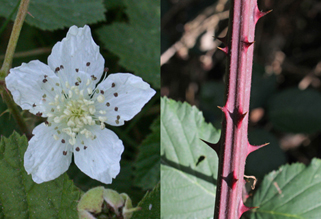 |
Brambles
Generally low-growing, sprawling shrubs with wiry, trailing or arching stems that are armed with an array of bristles, prickles or spikes. Branches are usually purple or green, but may be covered in a whitish 'pruinescence' or bloom in some species. Some stronger-growing species may scramble much higher amongst taller vegetation. Flowers white or pink, single or in clustered heads and followed by familiar blackberry or raspberry fruits which may be red or purple-black when ripe. Leaves usually with either three or five leaflets but some species may have single, three-lobed leaves or have compound leaves. |
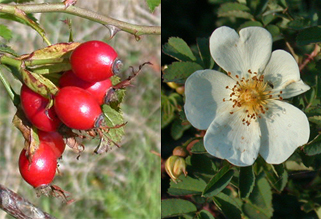 |
Roses
Familiar plants of roadsides and hedges with relatively large flowers, typically carried singly, but sometimes in clusters in some of the cultivated species. Leaves are pinnate, most species having seven or more leaflets per leaf. Stems thorny. Fruits are 'hips' - relatively large fruits that may be bright red or dark purple and have a number of hard pips or stones inside. |
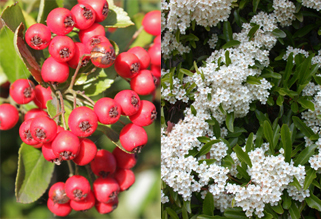 |
Firethorns
These are popular, ornamental shrubs that produce masses of flowers in spreading panicles, followed by large clusters of red or orange berries. The leaves are mostly narrow with toothed margins and the stems are spiny. The berries have a cluster of five hard pips or stones inside. |
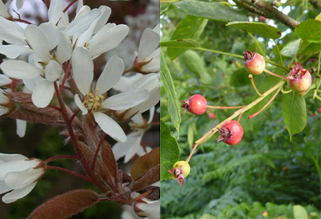 |
Juneberries
There are quite a number of juneberries in cultivation and the species can be very difficult to tell apart. Fortunately, perhaps, few of them occur in the wider countryside so identification becomes a little easier. Juneberry flowers open with the leaves in mid-spring and the narrow-petalled flowers are carried in upright spikes called racemes. The leaves are bronzy or pinkish-brown when they first open and are rather delicate with slender stalks. Fruits are small, dull red berries, carried on long stalks and with relatively large calyx lobes remaining attached. |
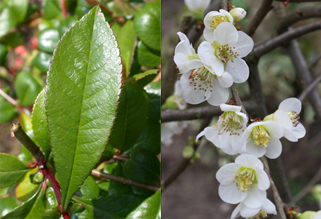 |
Flowering Quinces
Twiggy shrubs with relatively large, showy flowers, opening early (sometimes as early as January) on bare stems, well before the leaf buds open. Plants are usually red or pink-flowered, but some varieties are white. Fruits may be present from the previous year and resemble small apples. Leaves simple, typically around 3-4cm long. |
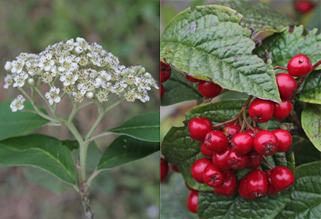 |
Cotoneasters
A relatively large group of rather variable species, from tall, tree-sized (though usually multistemmed) plants to low groundcover. Flowers may be single, in small clusters of two to five, or in large, many-flowered clusters. Leaves simple, deciduous or evergreen, never toothed or compound. Fruits are small, rather firm berries, usually red but sometimes orange or yellow. Inside, they have a cluster of typically one to five hard pips or stones. |
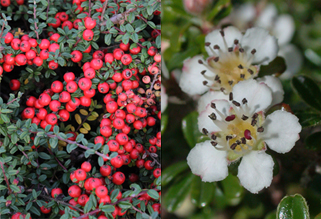 |
Cotoneasters
A relatively large group of rather variable species, from tall, tree-sized (though usually multistemmed) plants to low groundcover. Flowers may be single, in small clusters of two to five, or in large, many-flowered clusters. Leaves simple, deciduous or evergreen, never toothed or compound. Fruits are small, rather firm berries, usually red but sometimes orange or yellow. Inside, they have a cluster of typically one to five hard pips or stones. |
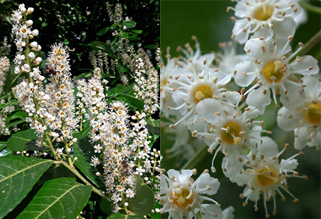 |
Cherry Laurels
Evergreen shrubs that can reach a tall size and have tough, leathery, shiny leaves. The flowers are carried in long spikes of many flowers, which may stand upright or hang down. Flowers are followed by berries that change from green, through red, to almost black. These plants are commonly known as laurels, although they are not true laurels but are really evergreen cherries. |
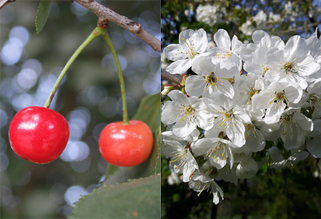 |
Cherries
A variable group of shrubs or medium to tall trees which are typically spineless. Flowers pink or white (sometimes double-flowered in ornamental varieties), carried singly or in small clusters, or sometimes in elongated racemes. The important feature in this group is that the red, yellow or dark reddish purple fruits contain a single, hard stone at the centre, which in plums is typically not flattened in one plane. Leaves simple, usually with toothed margins and often with small, reddish nectar glands at the base of the blade. |
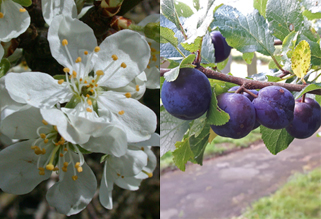 |
Plums
A variable group of suckering shrubs to medium or tall trees which may be spiny or spineless. Flowers pink or white (sometimes double-flowered in ornamental varieties), carried singly or in small clusters. The important feature in this group is that the green, yellow or blue-purple fruits contain a single, hard stone at the centre, which in plums is typically somewhat flattened in one plane. Leaves simple, usually with toothed margins. |
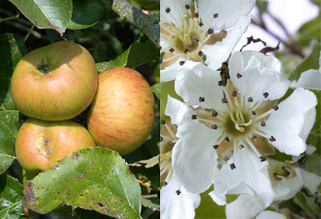 |
Apple & Pears
Although their fruits are distinctive and familiar, apples and pears are rather similar in their flowers. This group consists of small trees with simple leaves and white or pink and white flowers. The flowers are single or carried in small clusters on short, woody spurs on the main stems. Fruits large and solitary or smaller and in clusters of one to five. Green/brown, yellow or red-flushed, with whitish flesh and two to five small, dark pips at the centre, the latter contained within a cartilaginous wall. Branches are overall spineless, but the odd one or two spines may be found on wild populations. |
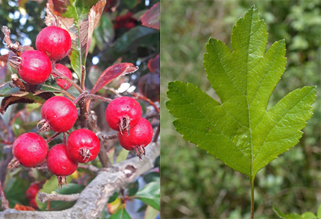 |
Hawthorns
Small trees, although often clipped and used as hedging on roadsides. Most species are spiny but some cultivated forms are spineless. Flowers in loose clusters; fruits red, small, in clusters, with one to five small stones inside. Leaves simple but very variable in shape, from entire-edged to coarsely toothed or deeply lobed. |
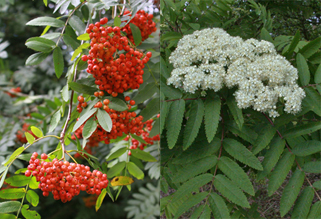 |
Rowans
Small to medium-sized trees with spineless branches. The flowers are relatively small for this family, but carried in spreading, flat-topped panicles. Fruits are usually red or orange, small but carried in large bunches; inside they have two to four pips or small stones at the centre. The fruits are typically smaller and carried in larger clusters than those of the whitebeams. Leaves are often compound, but sometimes merely deeply lobed and becoming compound at the base. |
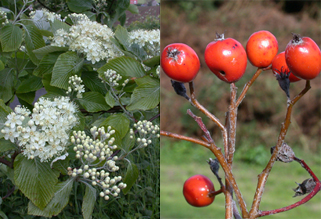 |
Whitebeams
Small to medium-sized trees with spineless branches. The flowers are relatively small for this family, but carried in spreading, flat-topped panicles. Fruits are red or orange, or sometimes brownish, small but carried in large bunches; inside they have two to four pips or small stones at the centre. The fruits are typically larger and carried in smaller clusters than those of the rowans. Leaves are usually simple and often whitish beneath, sometimes lobed or even becoming compound at the base. |